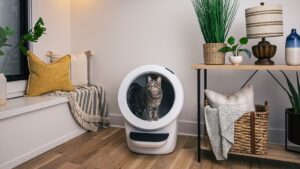The purpose of self-cleaning litter boxes is to eliminate the need to scoop waste by hand – a chore that many cat owners hate. These gadgets use sensors and other mechanisms to detect when a cat uses the litter box and mechanically rake, scoop or sift the feces into a compartment or disposable container.
Benefits of self-cleaning litter boxes
There are many benefits to self-cleaning litter boxes. First, they no longer have to shovel every day, which saves time and labor. They also help keep the litter box cleaner and more hygienic, which is crucial for cats and their owners.
Understand how a self-cleaning litter box works: Self-cleaning litter boxes use different methods to function, such as a rake, screen or scoop system. While some versions use a timer or weight sensor to start a cleaning cycle, others rely on motion sensors to determine when a cat has used the litter box.
Some tips for keeping a self-cleaning litter box clean
Choose the right trash can
To keep your self-cleaning litter box clean, you need to choose the right type of cat litter. Choose a clumping litter that is suitable for your device; stay away from varieties that are overly perfumed or dusty.
Ongoing maintenance
Maintain your self-cleaning litter box regularly to prevent the build-up of dirt and bacteria. This includes cleaning interior surfaces, replacing trash as necessary and emptying waste containers.
Keep an eye on the waste level
To prevent overflows or blockages, monitor the amount of waste in your self-cleaning bin and empty it as quickly as possible.
Sensor and mechanism cleaning
To ensure accurate detection and operation, clean your self-cleaning bin’s sensors and mechanisms regularly. Use a soft cloth or brush to remove any material or dirt residue that may prevent the sensor from functioning properly.
Check if there are any problems
Check your self-cleaning litter box regularly for signs of wear or malfunction. Prompt resolution of problems ensures continued operation and avoids more serious problems.
Typical mistakes to avoid
While self-cleaning litter boxes are convenient, there are some typical mistakes that pet owners should be aware of. These include using inappropriate waste, skipping routine maintenance and being slow to resolve problems.
In brief
To keep your cat’s environment sanitary and for your self-cleaning litter box to perform optimally, you need to keep it clean. By following the above advice and avoiding common mistakes, you can easily use a self-cleaning litter box without sacrificing cleanliness.
Frequently Asked Questions
How often should my self-cleaning litter box be cleaned?
Basic maintenance should be performed at least weekly, including cleaning the exterior and emptying the waste chamber. However, the frequency may vary depending on the number of cats using the litter box and the type of litter used.
Can any type of cat litter be used when using a self-cleaning litter box?
Although many self-cleaning litter boxes are suitable for different types of waste, it is important to follow the manufacturer’s instructions. For best results, clumping cat litter is usually the best choice.
What’s wrong with my self-cleaning litter box?
Self-cleaning litter boxes can fail for a variety of reasons, including sensor failure, mechanical failure, or poor maintenance. For troubleshooting suggestions, refer to the manufacturer’s instructions or contact customer service.
How do I know when my self-cleaning litter box needs new litter?
Pay attention to the amount of litter and look for any signs of clumping or unpleasant odors. Even if the litter box looks clean, it is usually best to replace it completely every few weeks to maintain optimal freshness and hygiene.
How many cats can use a self-cleaning litter box?
Self-cleaning litter boxes can accommodate multiple cats, but it is important to choose a model with sufficient capacity and consider the maintenance requirements of the litter box. Routine maintenance and monitoring are especially important for multi-cat households.


